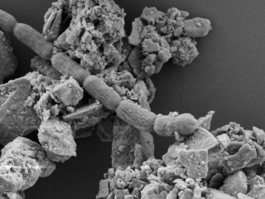LASM - Laboratory of Applied Space Microbiology
ABOUT OUR RESEARCH
We want to help make human expeditions beyond Earth sustainable.
Our focus is on the development of microbe-based technologies for long-term missions to Mars. One challenge there lies in providing essential consumables, which could be solved by producing these from Martian resources. Biology provides a solution: various organisms have the ability to produce drugs, food, oxygen, biomaterials and various chemicals, to mine metals and to process waste. But if biological systems must consume materials hauled from Earth, their running time without replenishment is limited. We therefore seek to understand how given microorganisms could serve as primary producers: how they could be fed from local materials and then support the growth of other organisms, opening the way to a wide range of biotechnologies.
Despite the name of our team, we do not restrict our work to microbiology. Reaching our goal requires accounting for the broader context; we therefore allow ourselves contributions to projects dealing with, for instance, engineering, materials science or planetary protection.
Green bacteria on a red planet
A large part of our work relies on cyanobacteria: fed with materials available in the Martian ground and atmosphere, they could provide feedstock for a range of bioprocesses which, in turn, could produce a wide range of consumables.
This video explains why we chose a specific species among them – Anabaena sp. PCC 7938 – as a model, and how they could be used to support Mars missions.
Our fields of research
- Cyanobacterium-based life-support systems for space exploration
- Adaptive laboratory evolution (ALE) of cyanobacteria under Mars cultivation-like conditions
- Cyanobacterium-regolith interactions for in-situ resource utilization
- Multi-omics analysis of cyanobacterial adaptation to extreme conditions
- Cyanobacterial physiology under non-terrestrial atmospheres (low pressure, artificial gas compositions)
- Photobioreactor design supporting microbe-mineral interactions
CONTACT

Sustainable bioproduction on Mars
A long-term human presence on Mars requires a continuous provision of consumables for the crews. To help address this need, we are working to lay the foundation for sustainable bioproduction processes in Martian settlements. Our approach combines microbes and plants to produce essential resources, from fertilizers to food to bioplastics to oxygen, as well as to recycle organic waste – all starting from materials available in Mars’s ground and atmosphere. Our system is versatile and modular; it could be used to connect further bioprocesses to local resources, thereby alleviating the need for consumables imported from Earth. This research is funded through the University of Bremen's Humans on Mars Initiative and is carried in collaboration with the groups of Prof. Dr. Sven Kerzenmacher (UFT, Uni. Bremen) and Dr. Daniel Schubert (DLR Bremen).

Adaptive laboratory evolution of cyanobacteria
We use adaptive laboratory evolution methods to increase the fitness of cyanobacteria to conditions relevant to their cultivation on Mars. We mainly focus on resistance to perchlorate, a toxic compound widespread in Martian regolith, as well as abilities to use regolith substrates. We then investigate, at the genomic, proteomic, metabolomic, and physiological levels the adaptaions that enable improved fitness under these conditions. These insights contribute to the development of microbial systems for in-situ resource utilization, oxygen production, and bioremediation in future space missions.

Cyanobacterium-regolith interactions
We aim at understanding how Anabaena sp. adapts to direct contact with Martian regolith, investigating its ability to attach, form biofilms, and derive nutrients from it. By employing geomicrobiology and multi-omics approaches, we explore their responses at both physiological and molecular levels, aiming to unlock their potential for life support and ISRU on Mars.

Cyanobacterium responses to unusual atmospheres
Using Atmos, a photobioreactor made in-house and in which atmospheric pressure and gaz composition can be controlled, we study how cyanobacteria respond to changes in given atmospheric parameters. This helps us predict their growth in conditions foreseen for their cultivation on Mars.


The list below shows the latest 25 publications of this research group. For the complete, searchable list of ZARM publications, please click more
2025
Conclusion: Horizons of Red and Green
Mars and the Earthlings: A Realistic View on Mars Exploration and Settlement
Page 391—397
Publisher: Springer Nature Switzerland Cham
2025
391—397
Introduction: Seeing Through the Martian Dust
Mars and the Earthlings: A Realistic View on Mars Exploration and Settlement
Page 1—3
Publisher: Springer Nature Switzerland Cham
2025
1—3
Cyanobacteria as a substrate for heterotrophs—Implications for biological life-support systems on Mars.
I Talks 5 :68
Cyanobacteria in support of human lunar bases. Why? How?
Mars and the Earthlings: A Realistic View on Mars Exploration and Settlement
2024
BioMoon: a concept for a mission to advance space life sciences and astrobiology on the Moon
Discover Space, 128 (1) :5
2024
Publisher: Springer Netherlands Dordrecht
BioSigN: A space experiment on the ISS as preparation for insitu life detection missions and habitability studies
2024
Cultivation and nutritional characteristics of Chlorella vulgaris cultivated using Martian regolith and synthetic urine
Life Sciences in Space Research, 42 :108—116
2024
Publisher: Elsevier
Dependence of cyanobacterium growth and Mars-specific photobioreactor mass on total pressure, pN2 and pCO2
npj Microgravity, 10 (1) :101
2024
Publisher: Nature Publishing Group UK London
Effects of atmospheric pressure, and of the partial pressures of CO2 and N2, on the growth rates of Anabaena sp. PCC 7938: Assessment and implications for cyanobacterium cultivation on Mars
2024
Impact of low-dose X-ray radiation on the lipidome of Chlorella vulgaris
Algal Research, 84 :103783
2024
Publisher: Elsevier
Nutrient Composition & In-Situ Irrigation Capabilities for Space Crop Production Systems
2024
Presentations at the 2022 MELiSSA conference—current and future ways to closed life support systems
2024
Resource-efficiency of cyanobacterium production on Mars: Assessment and paths forward
Algal Research, 84 :103801
2024
Publisher: Elsevier
Sustainable Bioproduction on Mars Subproject 3: Hardware & Integrated Testing
2024
2023
An airlock concept to reduce contamination risks during the human exploration of Mars
npj Microgravity, 9 (1) :81
2023
Publisher: Nature Publishing Group UK London
Integration of a photobioreactor into the MaMBA facility as part of a human-centered life support system
52nd International Conference on Environmental Systems, Page ICES—2023
2023
Plant and microbial science and technology as cornerstones to Bioregenerative Life Support Systems in space
npj Microgravity, 9 (1) :69
2023
Publisher: Nature Publishing Group UK London
Sustainable Bioproduction on Mars
2023
Sustainable Bioproduction on Mars: Setting the ground for sustainable bioproduction in a Martian settlement
2023
The MaMBA facility as a testbed for bioregenerative life support systems
Life Sciences in Space Research, 36 :86—89
2023
Publisher: Elsevier
2022
A vision for Human Mars Exploration made in Bremen
44th COSPAR Scientific Assembly. Held 16-24 July, 44 :3186
2022
An airlock of a human habitat on Mars conforming to planetary protection goals
44th COSPAR Scientific Assembly. Held 16-24 July, 44 :3281
2022
Bioregenerative life-support systems for crewed missions to the Moon and Mars
2022
Biosignature stability in space enables their use for life detection on Mars
Science advances, 8 (36) :eabn7412
2022
Publisher: American Association for the Advancement of Science



